Page 173 of 304
173 Operation
Engine compartment
You can check the engine oil level with
the oil dipstick�
Open the hood (
�page 171).
�
Pull out oil dipstick1 (
�page 175) and
wipe the tip clean.
�
Reinsert the oil dipstick into the dip-
stick guide tube as far as it will go.
1Oil dipstick
�
Pull out the oil dipstick again after
approximately 3 seconds.
The oil level is acceptable when it
leaves a line between the upper and
lower marks of the dipstick.
For adding oil (
�page 175).
See “Practical hints” (
�page 200) if the
low engine oil level warning lamp in the in-
strument cluster lights up.You can check the engine oil level on the
odometer display (SLK 320 and
SLK 32 AMG only)
�
Turn the key in the steering lock to
position2.
1Knob
�
Wait until the symbols
:
and
I
appear in the odometer display indica-
tor.
iFill quantity between upper and lower
dipstick marking level is approximately
2.1 US qt (2.0 l).
��
Page 174 of 304
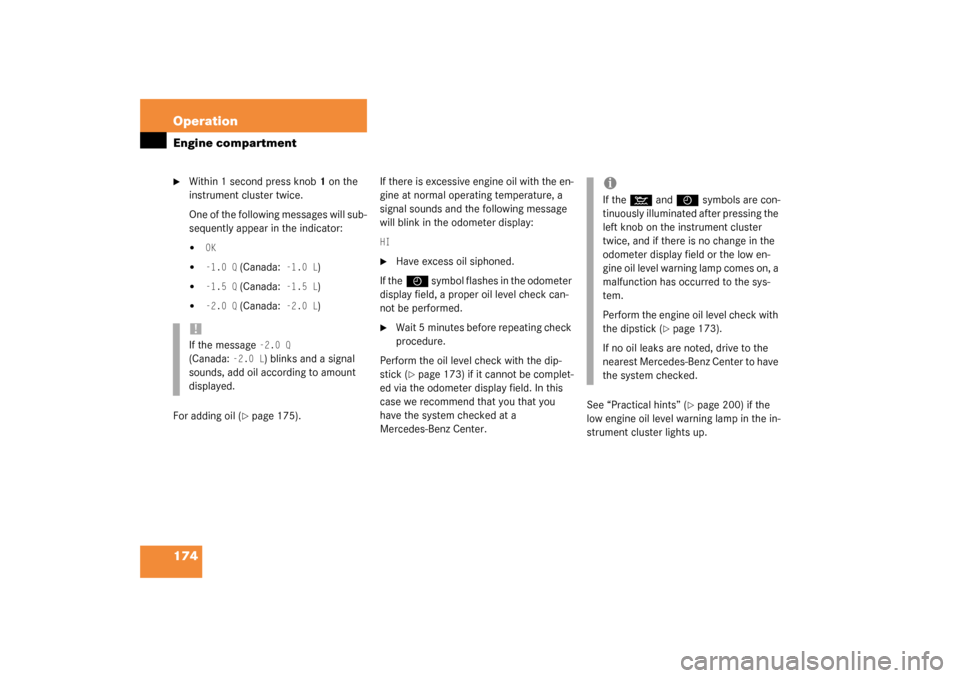
174 OperationEngine compartment�
Within 1 second press knob1 on the
instrument cluster twice.
One of the following messages will sub-
sequently appear in the indicator:�
OK
�
-1.0 Q
(Canada:
-1.0 L
)
�
-1.5 Q
(Canada:
-1.5 L
)
�
-2.0 Q
(Canada:
-2.0 L
)
For adding oil (
�page 175).If there is excessive engine oil with the en-
gine at normal operating temperature, a
signal sounds and the following message
will blink in the odometer display:
HI�
Have excess oil siphoned.
If theI
symbol flashes in the odometer
display field, a proper oil level check can-
not be performed.
�
Wait 5 minutes before repeating check
procedure.
Perform the oil level check with the dip-
stick (
�page 173) if it cannot be complet-
ed via the odometer display field. In this
case we recommend that you that you
have the system checked at a
Mercedes-Benz Center.See “Practical hints” (
�page 200) if the
low engine oil level warning lamp in the in-
strument cluster lights up.
!If the message
-2.0 Q
(Canada:
-2.0 L
) blinks and a signal
sounds, add oil according to amount
displayed.
iIf the
:
and
I
symbols are con-
tinuously illuminated after pressing the
left knob on the instrument cluster
twice, and if there is no change in the
odometer display field or the low en-
gine oil level warning lamp comes on, a
malfunction has occurred to the sys-
tem.
Perform the engine oil level check with
the dipstick (
�page 173).
If no oil leaks are noted, drive to the
nearest Mercedes-Benz Center to have
the system checked.
Page 176 of 304
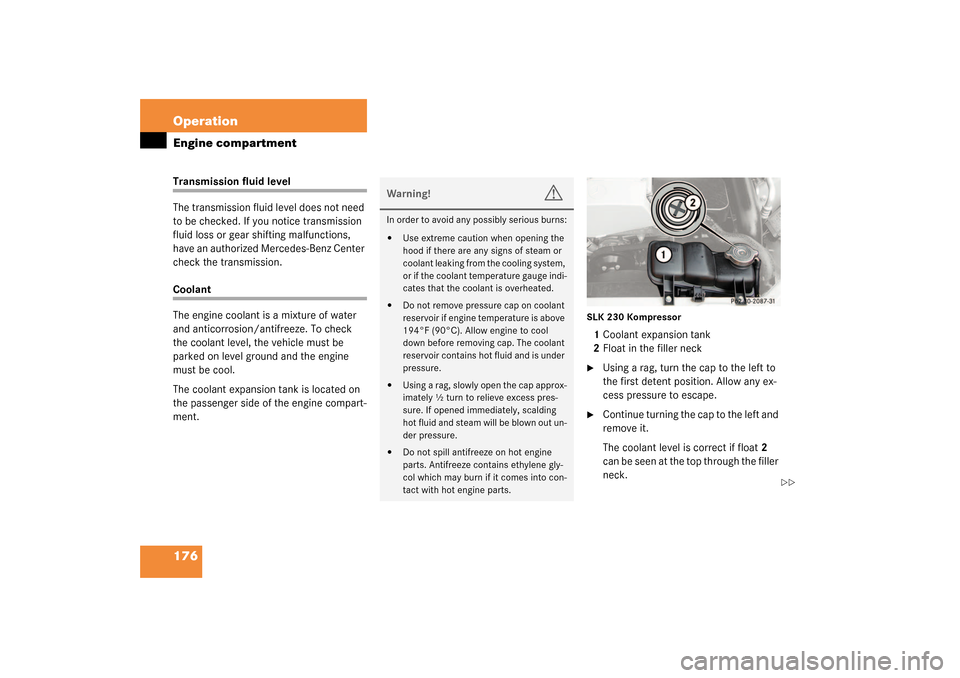
176 OperationEngine compartmentTransmission fluid level
The transmission fluid level does not need
to be checked. If you notice transmission
fluid loss or gear shifting malfunctions,
have an authorized Mercedes-Benz Center
check the transmission.Coolant
The engine coolant is a mixture of water
and anticorrosion/antifreeze. To check
the coolant level, the vehicle must be
parked on level ground and the engine
must be cool.
The coolant expansion tank is located on
the passenger side of the engine compart-
ment.
SLK 230 Kompressor1Coolant expansion tank
2Float in the filler neck�
Using a rag, turn the cap to the left to
the first detent position. Allow any ex-
cess pressure to escape.
�
Continue turning the cap to the left and
remove it.
The coolant level is correct if float2
can be seen at the top through the filler
neck.
Warning!
G
In order to avoid any possibly serious burns:�
Use extreme caution when opening the
hood if there are any signs of steam or
coolant leaking from the cooling system,
or if the coolant temperature gauge indi-
cates that the coolant is overheated.
�
Do not remove pressure cap on coolant
reservoir if engine temperature is above
194°F (90°C). Allow engine to cool
down before removing cap. The coolant
reservoir contains hot fluid and is under
pressure.
�
Using a rag, slowly open the cap approx-
imately ½ turn to relieve excess pres-
sure. If opened immediately, scalding
hot fluid and steam will be blown out un-
der pressure.
�
Do not spill antifreeze on hot engine
parts. Antifreeze contains ethylene gly-
col which may burn if it comes into con-
tact with hot engine parts.
��
Page 178 of 304
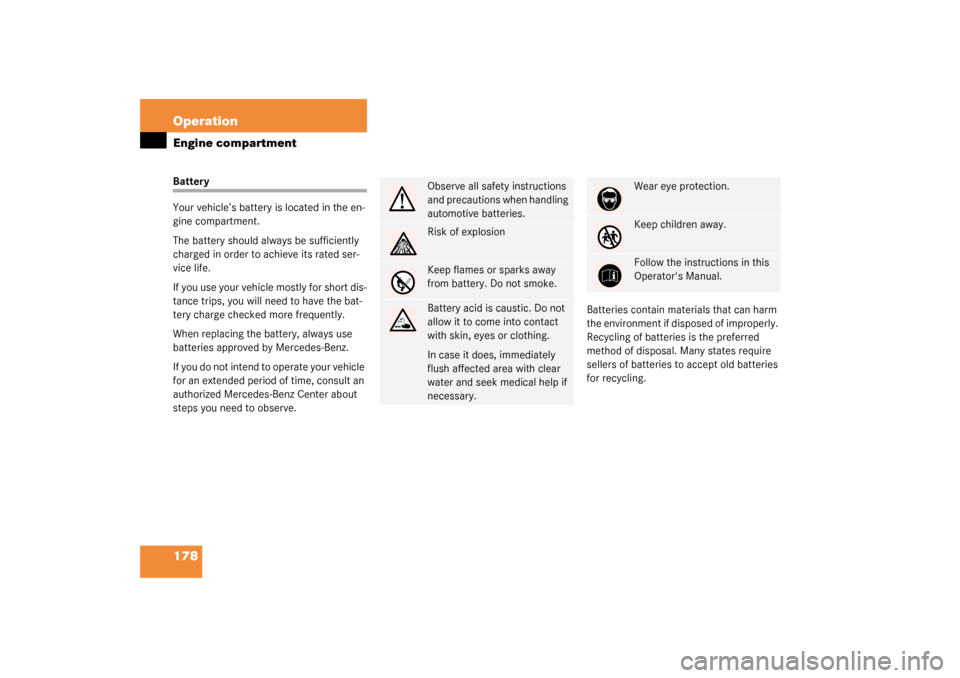
178 OperationEngine compartmentBattery
Your vehicle’s battery is located in the en-
gine compartment.
The battery should always be sufficiently
charged in order to achieve its rated ser-
vice life.
If you use your vehicle mostly for short dis-
tance trips, you will need to have the bat-
tery charge checked more frequently.
When replacing the battery, always use
batteries approved by Mercedes-Benz.
If you do not intend to operate your vehicle
for an extended period of time, consult an
authorized Mercedes-Benz Center about
steps you need to observe.Batteries contain materials that can harm
the environment if disposed of improperly.
Recycling of batteries is the preferred
method of disposal. Many states require
sellers of batteries to accept old batteries
for recycling.
Observe all safety instructions
and precautions when handling
automotive batteries.Risk of explosionKeep flames or sparks away
from battery. Do not smoke.Battery acid is caustic. Do not
allow it to come into contact
with skin, eyes or clothing.
In case it does, immediately
flush affected area with clear
water and seek medical help if
necessary.
Wear eye protection.Keep children away.Follow the instructions in this
Operator's Manual.
Page 183 of 304
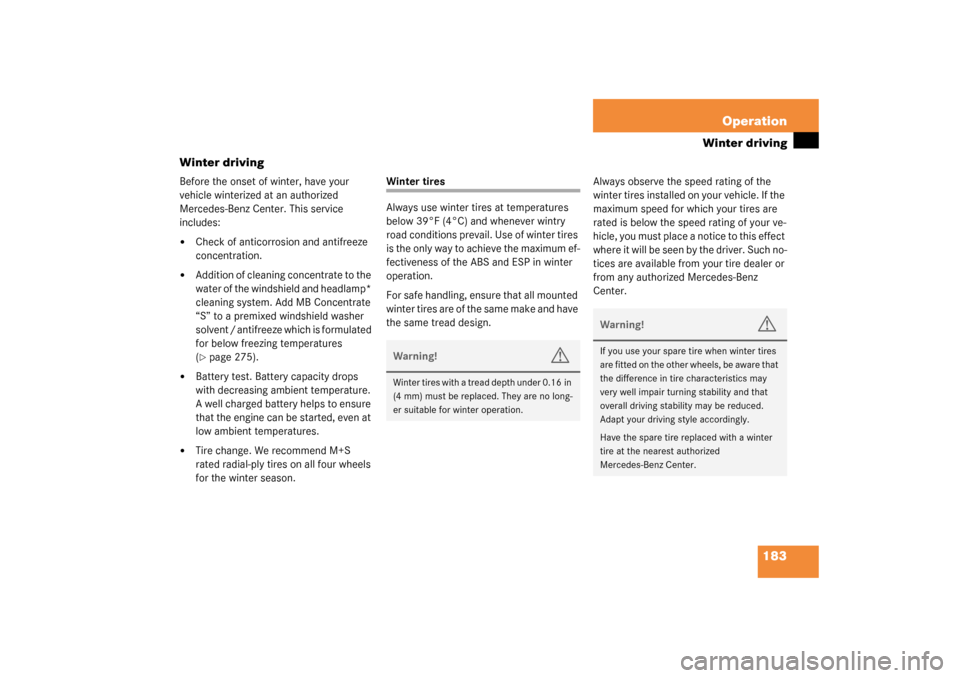
183 Operation
Winter driving
Winter driving
Before the onset of winter, have your
vehicle winterized at an authorized
Mercedes-Benz Center. This service
includes:�
Check of anticorrosion and antifreeze
concentration.
�
Addition of cleaning concentrate to the
water of the windshield and headlamp*
cleaning system. Add MB Concentrate
“S” to a premixed windshield washer
solvent / antifreeze which is formulated
for below freezing temperatures
(�page 275).
�
Battery test. Battery capacity drops
with decreasing ambient temperature.
A well charged battery helps to ensure
that the engine can be started, even at
low ambient temperatures.
�
Tire change. We recommend M+S
rated radial-ply tires on all four wheels
for the winter season.
Winter tires
Always use winter tires at temperatures
below 39°F (4°C) and whenever wintry
road conditions prevail. Use of winter tires
is the only way to achieve the maximum ef-
fectiveness of the ABS and ESP in winter
operation.
For safe handling, ensure that all mounted
winter tires are of the same make and have
the same tread design.Always observe the speed rating of the
winter tires installed on your vehicle. If the
maximum speed for which your tires are
rated is below the speed rating of your ve-
hicle, you must place a notice to this effect
where it will be seen by the driver. Such no-
tices are available from your tire dealer or
from any authorized Mercedes-Benz
Center.Warning!
G
Winter tires with a tread depth under 0.16 in
(4 mm) must be replaced. They are no long-
er suitable for winter operation.
Warning!
G
If you use your spare tire when winter tires
are fitted on the other wheels, be aware that
the difference in tire characteristics may
very well impair turning stability and that
overall driving stability may be reduced.
Adapt your driving style accordingly.
Have the spare tire replaced with a winter
tire at the nearest authorized
Mercedes-Benz Center.
Page 195 of 304
195 Practical hints
What to do if …?
Problem
Possible cause
Suggested solution
¿
The yellow BAS/ESP malfunction
indicator lamp comes on while
driving.
The ESP is deactivated because of an inter-
rupted power supply. The ABS may still be
operational.
�
With vehicle stationary and the engine
running, turn the steering wheel com-
pletely to the left and then to the right
to synchronize the ESP.
The BAS has detected a malfunction and
switched off. The brake system is still func-
tioning normally but without the BAS avail-
able.
�
Continue driving with added caution.
�
Have the system checked at an autho-
rized Mercedes-Benz Center as soon
as possible.
Failure to follow these instructions in-
creases the risk of accident.
The charging voltage has fallen below
10 volts and the BAS has switched off.
�
When the voltage is above this value
again, the BAS is operational again.
�
If necessary, have the alternator and
battery checked.
Page 196 of 304
196 Practical hintsWhat to do if …?Problem
Possible cause
Suggested solution
-
The yellow ABS malfunction indi-
cator lamp and warning comes
on while driving.
The ABS has detected a malfunction and has
switched off. The BAS and ESP are also
switched off. Both indicator lamps come on
with the engine running.
The brake system is still functioning normally
but without the ABS available.
�
Continue driving with added caution.
Wheels will lock during hard braking
reducing steering capability.
�
Have the system checked at an autho-
rized Mercedes-Benz Center as soon
as possible.
Failure to follow these instructions in-
creases the risk of an accident.
The charging voltage has fallen below
10 volts and the ABS has switched off.
�
When the voltage is above this value
again, the ABS is operational again.
�
If necessary, have the alternator and
battery checked.
Page 198 of 304
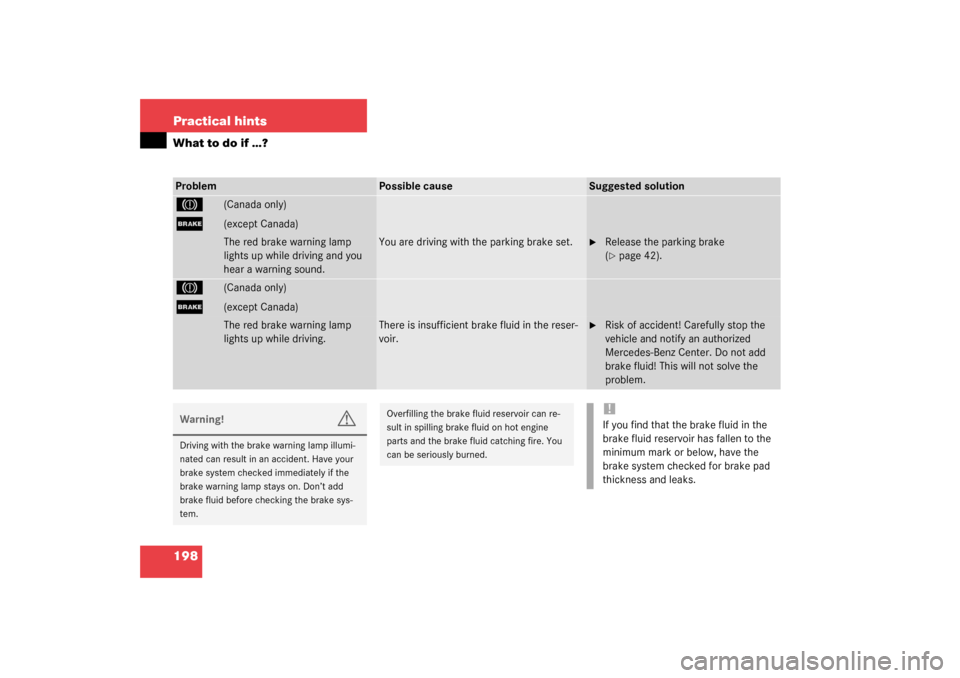
198 Practical hintsWhat to do if …?Problem
Possible cause
Suggested solution
3
(Canada only)
;
(except Canada)The red brake warning lamp
lights up while driving and you
hear a warning sound.
You are driving with the parking brake set.
�
Release the parking brake
(�page 42).
3
(Canada only)
;
(except Canada)The red brake warning lamp
lights up while driving.
There is insufficient brake fluid in the reser-
voir.
�
Risk of accident! Carefully stop the
vehicle and notify an authorized
Mercedes-Benz Center. Do not add
brake fluid! This will not solve the
problem.
Warning!
G
Driving with the brake warning lamp illumi-
nated can result in an accident. Have your
brake system checked immediately if the
brake warning lamp stays on. Don’t add
brake fluid before checking the brake sys-
tem.
Overfilling the brake fluid reservoir can re-
sult in spilling brake fluid on hot engine
parts and the brake fluid catching fire. You
can be seriously burned.
!If you find that the brake fluid in the
brake fluid reservoir has fallen to the
minimum mark or below, have the
brake system checked for brake pad
thickness and leaks.